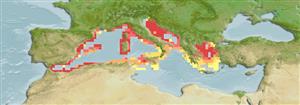>
Gobiiformes (Gobies) >
Gobiidae (Gobies) > Gobiinae
Etymology: Gobius: Latin, gobius = gudgeon (Ref. 45335); kolombatovici: Named for Juraj Kolombatovic (1843-1908), a Croatian taxonomist.
Eponymy: Juraj Kolombatovic (1843–1908) was a Croatian Professor of mathematics, a natural scientist, taxonomist and ichthyologist. [...] (Ref. 128868), visit book page.
Environment: milieu / climate zone / depth range / distribution range
Ecologia
marinhas demersal; intervalo de profundidade 15 - 90 m (Ref. 92840). Temperate
Mediterranean Sea: northern Adriatic Sea.
Tamanho / Peso / Idade
Maturity: Lm ? range ? - ? cm
Max length : 9.2 cm SL macho/indeterminado; (Ref. 37044); 9.1 cm SL (female)
Descrição suscinta
Chaves de identificação | Morfologia | Morfometria
Espinhos dorsais (total) : 7; Raios dorsais (total) : 13 - 14; Espinhos anais: 1; Raios anais : 13; Vértebras: 28. Distinguishable from the other north-eastern Atlantic and Mediterranean Gobius species by: (1) row g reaching lateral end of row o, (2) row o variably related to fellow in dorsal midline, usually connected or overlapping, but sometimes separate (in fig.4), (3) body and head with orange spots and blotches, body spots and blotches clearly visible even in preserved specimens, after loss of orange coloration, and (4) first dorsal fin with black blotch in upper posterior corner, remaining also in preserved specimens. It further differs from G. cruentatus in (1) absence of cheek scales, and (2) shorter row x, not reaching pore ß anteriorly. G. kolombatovici also differs by a higher number of scales in lateral series (Ref. 37044).
Gobius kolombatovici is a bottom-dwelling and secretive species, observed at depths of 15-38 m. It was found to inhabit localities with a combination of soft sediment and rock. Common fish in the same habitat are epibenthic Gobius vittatus, Parablennius rouxi, Thorogobius macrolepis and hyper-benthic Coris julis, Chromis chromis and Serranus hepatus (Ref. 37044).
Ciclo de vida ou comportamento de acasalamento
Maturidade | Reprodução | Desova | Ovos | Fecundidade | Larvas
Kovačić, M. and P.J. Miller, 2000. A new species of Gobius (Teleostei: Gobiidae) from the northern Adriatic Sea. Cybium 24(3):231-239. (Ref. 37044)
Status na Lista Vermelha da UICN (Ref. 130435: Version 2024-1)
Ameaça para os humanos
Harmless
Uso pelos humanos
Ferramentas
Relatórios especiais
Baixar XML
Fontes da internet
Estimates based on models
Preferred temperature (Ref.
123201): 13.3 - 17, mean 14.7 °C (based on 26 cells).
Índice de diversidade filogenética (Ref.
82804): PD
50 = 0.5000 [Uniqueness, from 0.5 = low to 2.0 = high].
Bayesian length-weight: a=0.01023 (0.00477 - 0.02194), b=3.01 (2.83 - 3.19), in cm total length, based on LWR estimates for this (Sub)family-body shape (Ref.
93245).
Nível Trófico (Ref.
69278): 3.2 ±0.2 se; based on size and trophs of closest relatives
Resiliência (Ref.
120179): Elevada, tempo mínimo de duplicação da população menor que 15 meses (Preliminary K or Fecundity.).
Fishing Vulnerability (Ref.
59153): Low vulnerability (10 of 100).
